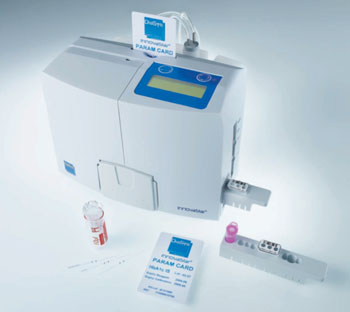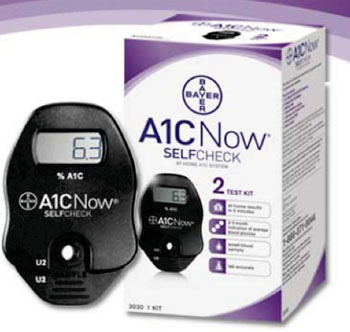Routine Blood Glucose Measurements Can Accurately Estimate HbA1c
|
By LabMedica International staff writers Posted on 06 May 2014 |

Image: A typical clinical laboratory diabetes analyzer (Photo courtesy of Innovastar).

Image: The A1CNow monitoring system for glycated hemoglobin (HbA1c) levels (Photo courtesy of Bayer).
Glycated hemoglobin or HbA1c is the standard measurement for assessing glycemic control over time in people with diabetes and blood levels of HbA1c are typically measured every few months in a laboratory.
The relationship between HbA1c and average glucose levels could determine whether HbA1c could be expressed and reported as average glucose in the same units as used in self-monitoring which could increase individuals' motivation to improve diabetes control.
Scientists at the University of Virginia (Charlottesville, VA, USA) working with those at Sanofi-Aventis Deutschland GmbH (Frankfurt, Germany) developed a data-based model that accurately estimates HbA1c using self-monitored blood glucose (SMBG) readings. The computer algorithm they developed was based on a training data set drawn from 379 subjects and then evaluated for accuracy on an independent test data set. The average HbA1c level was 7.6% (± 1.1%), with minimum and maximum values of 5.2% and 12.2%, respectively.
A conceptually new, clinically viable procedure was developed for real-time tracking of average glycaemia from self-monitoring data. The average glucose tracing can then be converted into running estimates of HbA1c, which can be presented to the patient daily. The computational demands of the procedure are low and therefore readily implementable into devices with limited processing power, such as home SMBG meter.
The procedure, tracking average glycaemia and HbA1c in real time, could provide valuable assistance to the daily optimization of diabetes control. The procedure is not intended as a substitute for laboratory assessments of HbA1c and it should be viewed as a surrogate measure that allows convenient tracing of average glucose, readily implementable in a point-of-care SMBG device.
Satish Garg, MD, a professor of medicine and pediatrics at the University of Colorado (Denver, CO, USA) said, “Patients are used to a HbA1c result from their doctor visits, and this study highlights simple estimated HbA1c values from SMBG data. This may become an important tool for improved patient self-management.” The study was published on April 23, 2014, in the journal Diabetes Technology & Therapeutics.
Related Links:
University of Virginia
Sanofi-Aventis Deutschland GmbH
University of Colorado
The relationship between HbA1c and average glucose levels could determine whether HbA1c could be expressed and reported as average glucose in the same units as used in self-monitoring which could increase individuals' motivation to improve diabetes control.
Scientists at the University of Virginia (Charlottesville, VA, USA) working with those at Sanofi-Aventis Deutschland GmbH (Frankfurt, Germany) developed a data-based model that accurately estimates HbA1c using self-monitored blood glucose (SMBG) readings. The computer algorithm they developed was based on a training data set drawn from 379 subjects and then evaluated for accuracy on an independent test data set. The average HbA1c level was 7.6% (± 1.1%), with minimum and maximum values of 5.2% and 12.2%, respectively.
A conceptually new, clinically viable procedure was developed for real-time tracking of average glycaemia from self-monitoring data. The average glucose tracing can then be converted into running estimates of HbA1c, which can be presented to the patient daily. The computational demands of the procedure are low and therefore readily implementable into devices with limited processing power, such as home SMBG meter.
The procedure, tracking average glycaemia and HbA1c in real time, could provide valuable assistance to the daily optimization of diabetes control. The procedure is not intended as a substitute for laboratory assessments of HbA1c and it should be viewed as a surrogate measure that allows convenient tracing of average glucose, readily implementable in a point-of-care SMBG device.
Satish Garg, MD, a professor of medicine and pediatrics at the University of Colorado (Denver, CO, USA) said, “Patients are used to a HbA1c result from their doctor visits, and this study highlights simple estimated HbA1c values from SMBG data. This may become an important tool for improved patient self-management.” The study was published on April 23, 2014, in the journal Diabetes Technology & Therapeutics.
Related Links:
University of Virginia
Sanofi-Aventis Deutschland GmbH
University of Colorado
Latest Clinical Chem. News
- Carbon Nanotubes Help Build Highly Accurate Sensors for Continuous Health Monitoring
- Paper-Based Device Boosts HIV Test Accuracy from Dried Blood Samples
- AI-Powered Raman Spectroscopy Method Enables Rapid Drug Detection in Blood
- Novel LC-MS/MS Assay Detects Low Creatinine in Sweat and Saliva
- Biosensing Technology Breakthrough Paves Way for New Methods of Early Disease Detection
- New Saliva Test Rapidly Identifies Paracetamol Overdose
- POC Saliva Testing Device Predicts Heart Failure in 15 Minutes

- Screening Tool Detects Multiple Health Conditions from Single Blood Drop
- Integrated Chemistry and Immunoassay Analyzer with Extensive Assay Menu Offers Flexibility, Scalability and Data Commutability
- Rapid Drug Test to Improve Treatment for Patients Presenting to Hospital
- AI Model Detects Cancer at Lightning Speed through Sugar Analyses
- First-Ever Blood-Powered Chip Offers Real-Time Health Monitoring
- New ADLM Guidance Provides Expert Recommendations on Clinical Testing For Respiratory Viral Infections
- 3D Printed Point-Of-Care Mass Spectrometer Outperforms State-Of-The-Art Models
- POC Biomedical Test Spins Water Droplet Using Sound Waves for Cancer Detection
- Highly Reliable Cell-Based Assay Enables Accurate Diagnosis of Endocrine Diseases
Channels
Molecular Diagnostics
view channel
RNA-Based Blood Test Detects Preeclampsia Risk Months Before Symptoms
Preeclampsia remains a major cause of maternal morbidity and mortality, as well as preterm births. Despite current guidelines that aim to identify pregnant women at increased risk of preeclampsia using... Read more
First Of Its Kind Test Uses microRNAs to Predict Toxicity from Cancer Therapy
Many men with early-stage prostate cancer receive stereotactic body radiotherapy (SBRT), a highly precise form of radiation treatment that is completed in just five sessions. Compared to traditional radiation,... Read moreNovel Cell-Based Assay Provides Sensitive and Specific Autoantibody Detection in Demyelination
Anti-myelin-associated glycoprotein (MAG) antibodies serve as markers for an autoimmune demyelinating disorder that affects the peripheral nervous system, leading to sensory impairment. Anti-MAG-IgM antibodies... Read moreHematology
view channel
New Scoring System Predicts Risk of Developing Cancer from Common Blood Disorder
Clonal cytopenia of undetermined significance (CCUS) is a blood disorder commonly found in older adults, characterized by mutations in blood cells and a low blood count, but without any obvious cause or... Read more
Non-Invasive Prenatal Test for Fetal RhD Status Demonstrates 100% Accuracy
In the United States, approximately 15% of pregnant individuals are RhD-negative. However, in about 40% of these cases, the fetus is also RhD-negative, making the administration of RhoGAM unnecessary.... Read moreImmunology
view channel
Stem Cell Test Predicts Treatment Outcome for Patients with Platinum-Resistant Ovarian Cancer
Epithelial ovarian cancer frequently responds to chemotherapy initially, but eventually, the tumor develops resistance to the therapy, leading to regrowth. This resistance is partially due to the activation... Read more
Machine Learning-Enabled Blood Test Predicts Immunotherapy Response in Lymphoma Patients
Chimeric antigen receptor (CAR) T-cell therapy has emerged as one of the most promising recent developments in the treatment of blood cancers. However, over half of non-Hodgkin lymphoma (NHL) patients... Read moreMicrobiology
view channel
Handheld Device Deliver Low-Cost TB Results in Less Than One Hour
Tuberculosis (TB) remains the deadliest infectious disease globally, affecting an estimated 10 million people annually. In 2021, about 4.2 million TB cases went undiagnosed or unreported, mainly due to... Read more
New AI-Based Method Improves Diagnosis of Drug-Resistant Infections
Drug-resistant infections, particularly those caused by deadly bacteria like tuberculosis and staphylococcus, are rapidly emerging as a global health emergency. These infections are more difficult to treat,... Read more
Breakthrough Diagnostic Technology Identifies Bacterial Infections with Almost 100% Accuracy within Three Hours
Rapid and precise identification of pathogenic microbes in patient samples is essential for the effective treatment of acute infectious diseases, such as sepsis. The fluorescence in situ hybridization... Read morePathology
view channel
Advanced Imaging Reveals Mechanisms Causing Autoimmune Disease
Myasthenia gravis, an autoimmune disease, leads to muscle weakness that can affect a range of muscles, including those needed for basic actions like blinking, smiling, or moving. Researchers have long... Read more
AI Model Effectively Predicts Patient Outcomes in Common Lung Cancer Type
Lung adenocarcinoma, the most common form of non-small cell lung cancer (NSCLC), typically adopts one of six distinct growth patterns, often combining multiple patterns within a single tumor.... Read moreTechnology
view channel
Pain-On-A-Chip Microfluidic Device Determines Types of Chronic Pain from Blood Samples
Chronic pain is a widespread condition that remains difficult to manage, and existing clinical methods for its treatment rely largely on self-reporting, which can be subjective and especially problematic... Read more
Innovative, Label-Free Ratiometric Fluorosensor Enables More Sensitive Viral RNA Detection
Viruses present a major global health risk, as demonstrated by recent pandemics, making early detection and identification essential for preventing new outbreaks. While traditional detection methods are... Read moreIndustry
view channel
Cepheid and Oxford Nanopore Technologies Partner on Advancing Automated Sequencing-Based Solutions
Cepheid (Sunnyvale, CA, USA), a leading molecular diagnostics company, and Oxford Nanopore Technologies (Oxford, UK), the company behind a new generation of sequencing-based molecular analysis technologies,... Read more
Grifols and Tecan’s IBL Collaborate on Advanced Biomarker Panels
Grifols (Barcelona, Spain), one of the world’s leading producers of plasma-derived medicines and innovative diagnostic solutions, is expanding its offer in clinical diagnostics through a strategic partnership... Read more






















